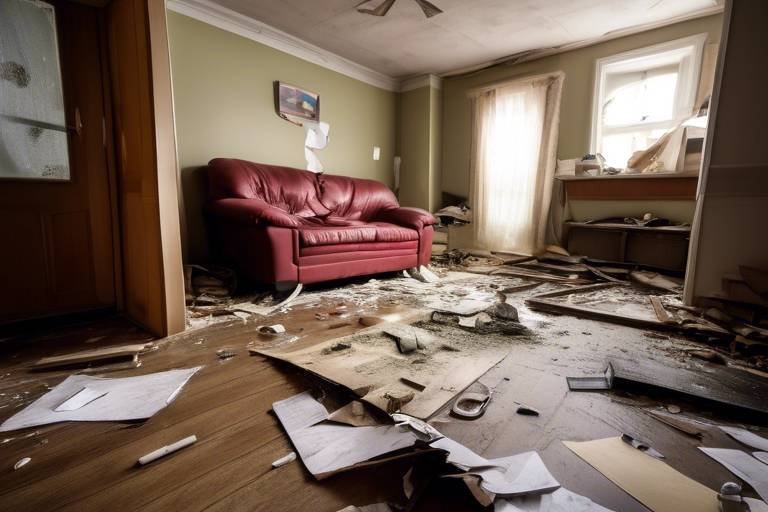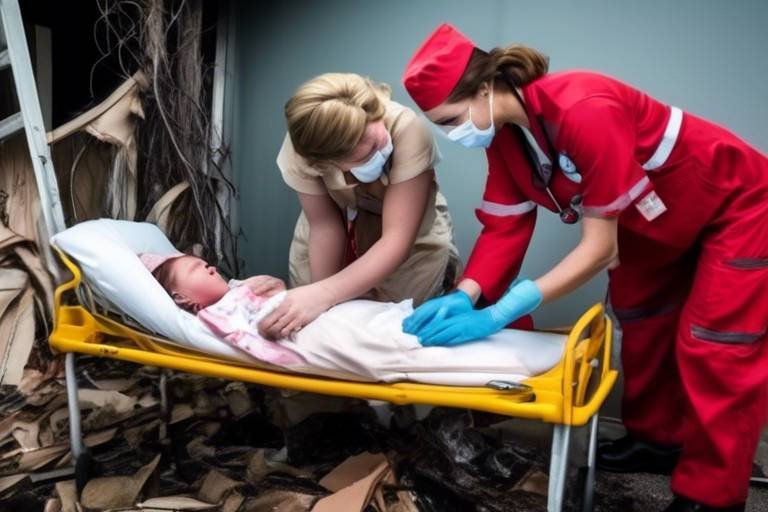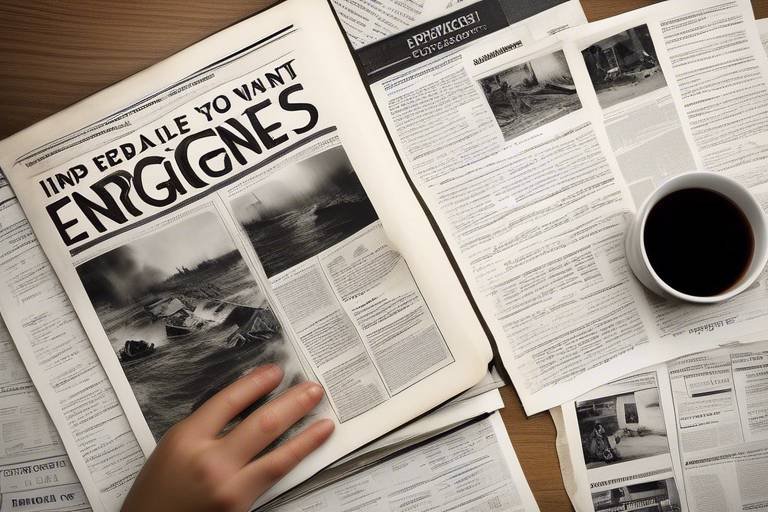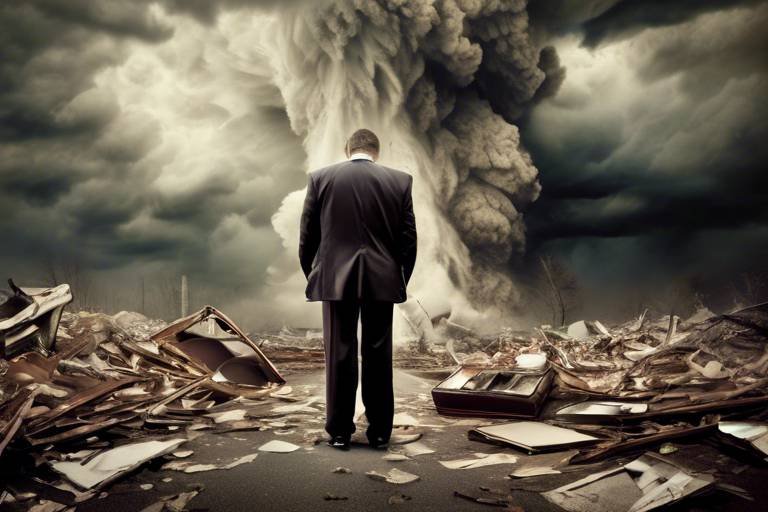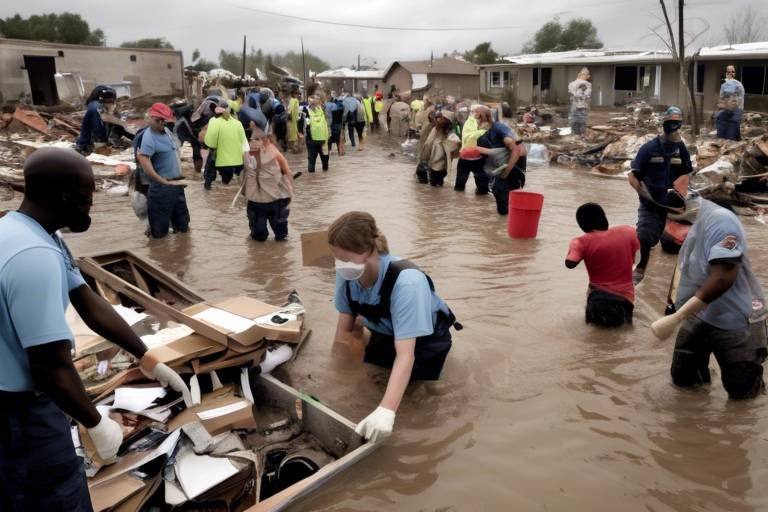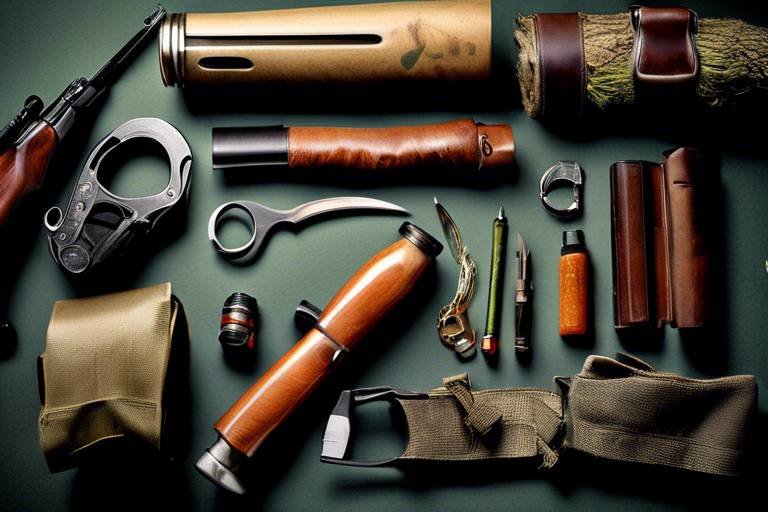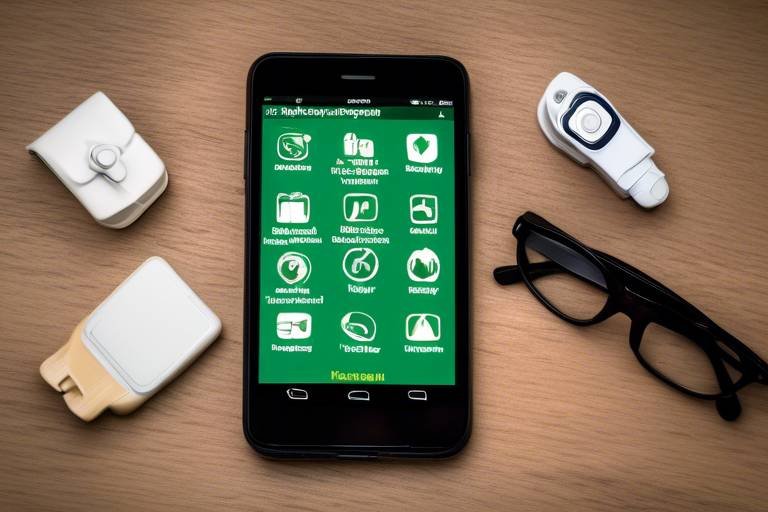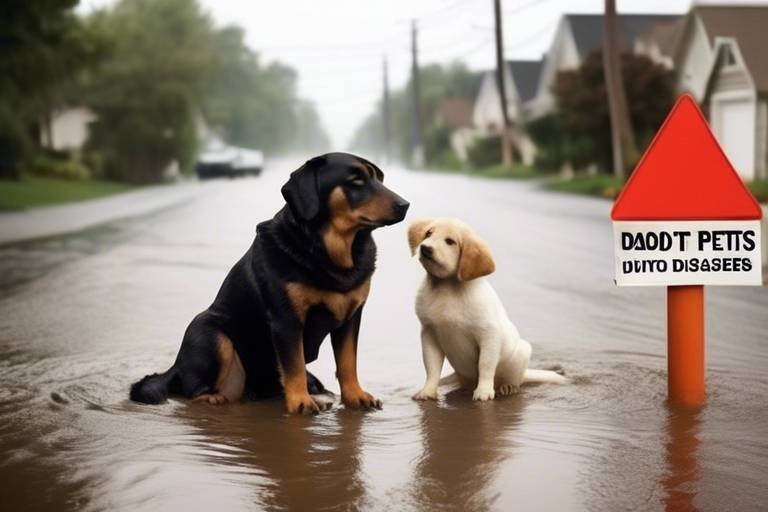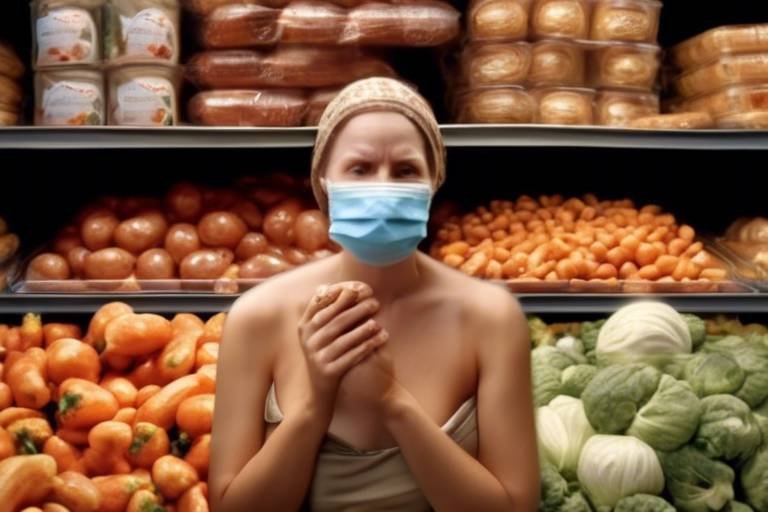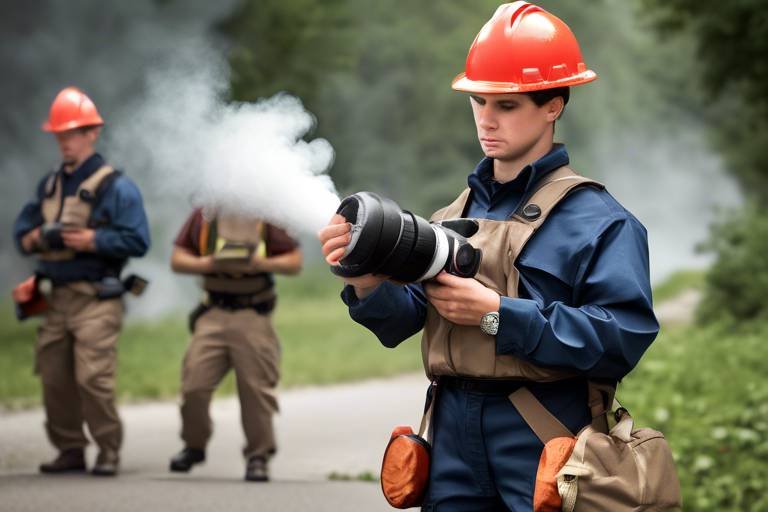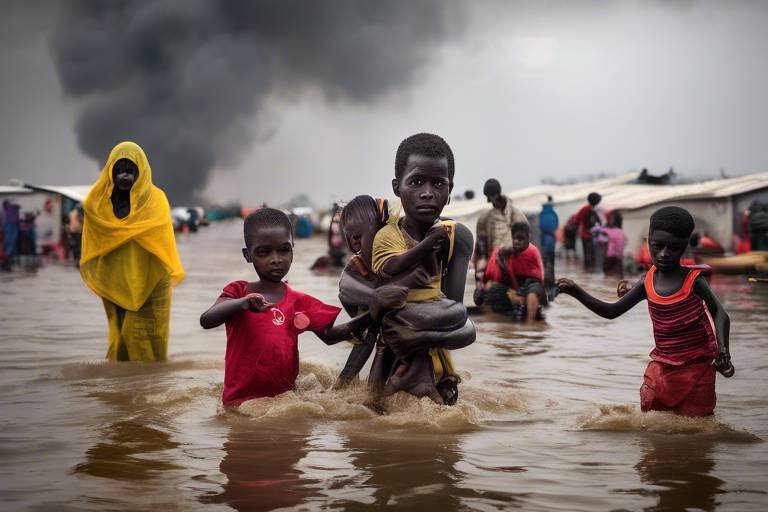Essential Items to Keep in Your Post-Disaster Comfort Kit
When disaster strikes, the chaos can be overwhelming. Whether it’s a natural calamity like a hurricane or an unforeseen event such as a house fire, having a well-prepared post-disaster comfort kit can make all the difference. Imagine being in a situation where basic necessities are out of reach; it can feel like being lost in a storm without a compass. This is why it’s crucial to gather essential items that not only ensure your survival but also provide a sense of comfort amidst the turmoil.
Think of your comfort kit as your lifeline, a beacon of hope when everything seems bleak. It’s not just about survival; it’s about maintaining your well-being during challenging times. A well-rounded kit can help you tackle physical needs, emotional stresses, and even logistical challenges that arise after a disaster. So, what exactly should you include in this vital kit? Let’s dive deeper into the essentials that can help you navigate through tough times with some semblance of normalcy.
Access to clean water is vital in a disaster scenario. Imagine going without water for even a day; it’s not just uncomfortable—it can be dangerous. It's recommended to store at least one gallon of water per person per day for a minimum of three days. But what happens when your supply runs out or becomes contaminated? This is where water purification methods come into play. You can include items such as water purification tablets, filters, or even a portable water purifier in your kit. These tools ensure that you can transform questionable water sources into safe drinking options.
Stocking non-perishable food items is essential for survival. Think about it: when the power goes out, your refrigerator becomes a cold box of disappointment. Instead, opt for foods that can withstand long durations without refrigeration. Items like canned goods, dried fruits, nuts, and energy bars are excellent choices. Not only do they provide vital nutrition, but they also have a long shelf life. You might even want to consider packing some comfort foods—like chocolate or granola bars—to lift spirits during tough times.
Having a well-stocked first aid kit can make a significant difference in emergencies. Accidents can happen, and when they do, you want to be prepared. Your kit should include essentials like band-aids, antiseptics, gauze, and pain relievers. But don't stop there! Consider adding items for specific needs, such as allergy medications or any personal prescriptions. In a post-disaster scenario, a little preparation can lead to a lot of peace of mind.
Tools can be invaluable in a disaster. Picture yourself in the aftermath of a storm, with debris scattered everywhere. A sturdy multi-tool can help you clear paths, make repairs, or even open cans of food. Flashlights are a must-have for navigating in the dark, and don’t forget extra batteries! You might also want to include a whistle or a signal mirror for emergency signaling. These items can turn a daunting situation into a manageable one.
Maintaining hygiene is crucial during a disaster. When facilities are limited, having personal hygiene products can greatly enhance your comfort and health. Pack items like wet wipes, hand sanitizers, toothbrushes, and toothpaste. You might also want to include feminine hygiene products and toilet paper. These small luxuries can provide a sense of normalcy and dignity when everything else feels chaotic.
Appropriate clothing and bedding can provide warmth and comfort. Depending on your geographical area, consider packing weather-appropriate clothing—think warm layers, sturdy shoes, and even rain gear. A couple of compact, lightweight blankets can also be a lifesaver. They not only offer warmth but can also serve as makeshift shelters or ground coverings. Remember, comfort is key, especially when you’re facing the unknown.
Staying informed is vital during a disaster. You wouldn’t want to be cut off from the world, right? Pack a battery-operated or hand-crank radio to receive updates and alerts. Don’t forget to include extra chargers for your mobile devices. In this digital age, your smartphone can be a lifeline, connecting you with loved ones and providing crucial information. Keep a power bank handy to ensure you can stay charged up when it matters most.
Keeping copies of important documents is crucial for recovery. Make sure to include items like identification, insurance papers, and medical records. You can store these documents in a waterproof bag to protect them from water damage. Having these papers on hand can expedite recovery processes and help you access necessary services when the dust settles.
Disasters can be emotionally taxing. In the midst of chaos, comfort items like books, toys, or even a favorite blanket can help soothe anxiety and provide emotional support during trying times. Think about what makes you feel safe and secure, and pack those items into your kit. Remember, mental health is just as important as physical health, especially in stressful situations.
Q: How often should I check my comfort kit?
A: It's a good idea to check your kit at least once a year to replace expired items and update any personal needs.
Q: How much water should I store?
A: Aim for at least one gallon per person per day for a minimum of three days.
Q: What are the best non-perishable foods to include?
A: Canned goods, dried fruits, nuts, and energy bars are excellent choices due to their long shelf life.
Q: Should I include pet supplies?
A: Absolutely! If you have pets, include food, water, and any necessary medications for them as well.

Water and Water Purification
Access to clean water is absolutely vital in any disaster scenario. Imagine being in a situation where your usual sources of drinking water are compromised—what would you do? That's why it's crucial to have a plan in place for storing and purifying water. The first step is to ensure that you have enough water stored in your comfort kit. A good rule of thumb is to have at least one gallon of water per person per day for at least three days. This takes into account drinking, cooking, and basic hygiene needs.
When it comes to storing water, use food-grade water containers to prevent contamination. Make sure to clean the containers thoroughly before filling them up. If you’re using tap water, it’s a good idea to add a few drops of unscented liquid household bleach to each gallon of water to help keep it safe. But what happens when your stored water runs out, or if you find yourself in an area without clean water sources? That’s where purification methods come into play.
There are several effective methods for purifying water, and knowing how to use them can make a world of difference. Here are a few methods you should consider:
- Boiling: This is one of the simplest and most effective ways to purify water. Bring water to a rolling boil for at least one minute (or three minutes at higher altitudes) to kill pathogens.
- Water Filters: Portable water filters can remove bacteria and protozoa. Look for filters that meet EPA standards for water purification.
- Chemical Purification: Water purification tablets, usually containing iodine or chlorine, can be a great backup option. Just follow the instructions on the package for safe usage.
It's also important to remember that some water sources might look clean but can still be contaminated. Always err on the side of caution. If you find yourself in a situation where you need to collect water from a natural source, try to choose water from a clear stream or spring rather than stagnant water. And as a final tip, consider carrying a small, portable water testing kit in your comfort kit. This can help you quickly assess whether a water source is safe to drink from.
In summary, having a reliable supply of clean water and knowing how to purify it can significantly enhance your safety and comfort during a disaster. It’s not just about surviving; it’s about maintaining your health and well-being. So, take the time now to prepare your water supply and purification methods. Your future self will thank you!

Non-Perishable Food Supplies
When disaster strikes, having a stockpile of can be the difference between comfort and chaos. Imagine finding yourself in a situation where fresh food is scarce, and you're left rummaging through empty cabinets. That's why it's crucial to think ahead and prepare your comfort kit with items that can withstand the test of time. Non-perishable foods are not just about survival; they can also provide a sense of normalcy and comfort during turbulent times.
So, what exactly qualifies as non-perishable food? These are foods that have a long shelf life and do not require refrigeration. Think of items that can be stored in your pantry for months or even years without spoiling. Some excellent choices include:
- Canned Goods: Beans, vegetables, fruits, and meats are all great options. They are packed with nutrients and can be easily heated up or eaten straight from the can.
- Dried Foods: Items like pasta, rice, and lentils are not only filling but also versatile. You can create various meals using these staples as a base.
- Granola Bars and Trail Mix: These snacks are perfect for quick energy boosts. They are easy to store and provide essential nutrients, making them ideal for stressful situations.
- Nut Butters: Peanut butter or almond butter can be a source of protein and healthy fats, keeping you satisfied for longer periods.
It's essential to consider nutritional balance when selecting your food supplies. Aim for a mix of carbohydrates, proteins, and fats to ensure you have the energy needed to face any challenges that arise. Additionally, don’t forget about dietary restrictions; if you or your loved ones have allergies or specific dietary needs, make sure to stock up on appropriate alternatives.
To help you organize your non-perishable food supplies, here’s a simple table outlining some recommended items along with their approximate shelf life:
| Food Item | Shelf Life |
|---|---|
| Canned Vegetables | 2-5 years |
| Dried Pasta | 2 years |
| Rice | 4-5 years |
| Peanut Butter | 1-2 years |
| Granola Bars | 6-12 months |
Moreover, consider how you will prepare these meals. If the power is out, you might not have access to a stove or microwave. Therefore, think about including items that can be eaten cold or require minimal preparation. For instance, canned soups can be eaten straight from the can, and granola bars make for a quick snack.
Lastly, don’t forget to rotate your supplies. Just like any good pantry, your comfort kit needs maintenance. Check expiration dates regularly and replace items as needed to ensure everything is fresh and ready to go when you need it most. By taking these steps, you can ensure that your non-perishable food supplies not only keep you nourished but also provide a sense of stability during uncertain times.
1. How often should I check my non-perishable food supplies?
It’s a good idea to check your supplies every six months to a year to ensure everything is still within the expiration date and to rotate out older items.
2. Can I include freeze-dried foods in my comfort kit?
Absolutely! Freeze-dried foods are lightweight, have a long shelf life, and can be rehydrated with water, making them an excellent addition to your kit.
3. What types of canned foods should I avoid?
Avoid canned foods that contain high levels of sodium or sugar, as these can be less healthy options. Instead, look for low-sodium or no-sugar-added varieties.

First Aid Supplies
When disaster strikes, having a well-stocked first aid kit can be the difference between a minor inconvenience and a major health crisis. It's like having a safety net; you hope you never need it, but when you do, you'll be incredibly grateful it’s there. So, what should you include in your first aid supplies? Let’s dive in!
First and foremost, you want to ensure you have the basics covered. Think of your first aid kit as a toolbox for your body. Just like you wouldn’t tackle a plumbing issue without a wrench, you shouldn’t face an emergency without the right medical supplies. Here’s a quick rundown of essential items to consider:
- Adhesive Bandages: For minor cuts and scrapes, these are your first line of defense.
- Gauze Pads and Adhesive Tape: For larger wounds that need more coverage.
- Antiseptic Wipes: To clean wounds and prevent infection.
- Antibiotic Ointment: To apply after cleaning a wound to help it heal.
- Pain Relievers: Include both ibuprofen and acetaminophen to tackle different types of pain.
- Emergency Blanket: This can help retain body heat in case of shock or cold exposure.
But it doesn’t stop there! Depending on your specific needs or those of your family, you might want to customize your kit further. For instance, if you have children, adding items like children’s pain relievers or thermometers can be incredibly useful. Similarly, if someone in your household has allergies, don’t forget to include antihistamines or an epinephrine auto-injector if prescribed.
Another crucial aspect of a first aid kit is the inclusion of a first aid manual. In the heat of the moment, it can be easy to forget what to do. A manual can serve as a quick reference guide, offering step-by-step instructions on how to handle various emergencies, from sprains to more serious injuries.
Now, let’s talk about organization. It’s not just about what you have, but how you store it. Consider using a durable, waterproof container to keep your supplies safe and dry. You can label compartments for easy access, ensuring that in a stressful situation, you can grab what you need without fumbling around. Remember, time is of the essence during emergencies!
| Essential First Aid Supplies | Purpose |
|---|---|
| Adhesive Bandages | For minor cuts and scrapes |
| Gauze Pads | For larger wounds |
| Antiseptic Wipes | To clean wounds |
| Antibiotic Ointment | To prevent infection |
| Pain Relievers | To alleviate pain |
| Emergency Blanket | To retain body heat |
Lastly, it’s wise to periodically check your first aid kit to ensure everything is up to date. Medications can expire, and supplies can deplete. Think of it like changing the batteries in your smoke detector—you don’t want to find out it’s empty when you need it most!
In summary, having a comprehensive first aid kit is not just a precaution; it’s a necessity. It empowers you to take control in emergencies, providing you with the tools you need to address injuries and health concerns effectively. So, take the time to build and maintain your kit, and you’ll be ready to face whatever challenges come your way.
Q: How often should I check my first aid kit?
A: It's a good idea to check your first aid kit every six months to ensure supplies are stocked and medications haven't expired.
Q: Can I use my first aid kit for minor illnesses?
A: Yes! Many first aid kits also include supplies for treating minor illnesses, such as fever reducers and cold medications.
Q: Where should I keep my first aid kit?
A: Store your first aid kit in a location that is easily accessible to all family members, such as the kitchen or a designated emergency area.

Emergency Tools and Equipment
When a disaster strikes, the chaos can be overwhelming. One minute you’re going about your day, and the next, you’re faced with the unexpected. This is where come into play, acting as your lifeline to safety and survival. Imagine having to navigate through debris or fix a broken window—having the right tools can make all the difference. So, what should you include in your comfort kit to ensure you’re prepared for anything?
First and foremost, a good multi-tool is a must-have. Think of it as your Swiss Army knife for emergencies. It combines several tools into one compact device, allowing you to tackle various tasks without lugging around a toolbox. From cutting ropes to opening cans, a multi-tool can be your best friend when you need to act quickly. If you’re wondering which features are essential, look for one that includes a knife, screwdriver, and pliers. Remember, versatility is key!
Next on the list is a reliable flashlight. When the lights go out, a flashlight becomes your guiding star. Opt for a durable, waterproof model that can withstand the rigors of a disaster scenario. Don’t forget to stock up on extra batteries, as they can be hard to find in the aftermath of an emergency. You might also consider a solar-powered flashlight to ensure you have a light source that won’t run out of juice when you need it most.
In addition to lighting, having a portable phone charger is crucial. In today’s world, staying connected is not just a luxury; it’s a necessity. Whether you need to call for help or check for updates, a charged phone can be a lifeline. Look for chargers that can power multiple devices and consider ones that can be recharged using solar energy. This way, you’re not left in the dark—literally and figuratively!
Moreover, you should include a first aid kit in your emergency tools. It’s not just about band-aids; a comprehensive kit should contain antiseptics, gauze, and even a few over-the-counter medications. It’s a good idea to familiarize yourself with the contents of your first aid kit and how to use them. Consider taking a first aid course to ensure you’re prepared to handle minor injuries effectively.
Lastly, don’t underestimate the power of a good whistle. In a crowded or chaotic situation, shouting for help can be exhausting and ineffective. A whistle is a simple yet powerful tool that can alert others to your location without draining your energy. It’s also lightweight and easy to carry, making it an ideal addition to your emergency kit.
In summary, having the right emergency tools and equipment can significantly enhance your safety and comfort during a disaster. By including multi-tools, flashlights, portable chargers, first aid kits, and whistles in your comfort kit, you’ll be better equipped to handle any situation that arises. Remember, preparation is the key to peace of mind!
1. What is the most important tool to have in a disaster?
While all tools are valuable, a multi-tool is often considered the most essential due to its versatility in various situations.
2. How can I ensure my flashlight is always ready to use?
Regularly check your flashlight and replace batteries as needed. Consider using a solar-powered flashlight to eliminate battery dependency.
3. What should I include in my first aid kit?
Your first aid kit should include antiseptics, bandages, gauze, scissors, adhesive tape, and over-the-counter medications like pain relievers and antihistamines.
4. How can I stay informed during a disaster?
Having a portable phone charger and a radio can help you stay updated on emergency broadcasts and maintain communication with loved ones.
5. Why is a whistle important?
A whistle is an effective way to signal for help without straining your voice, making it a vital tool in emergencies.

Personal Hygiene Products
When disaster strikes, maintaining personal hygiene becomes crucial, not just for physical health but also for mental well-being. Imagine being in a stressful situation without the basic supplies to keep yourself clean and comfortable. It can feel overwhelming, right? That's why including essential hygiene products in your post-disaster comfort kit is a must. These items not only help prevent illness but also provide a sense of normalcy amidst the chaos.
First and foremost, think about soap and sanitizers. In a disaster scenario, access to clean running water may be limited, making handwashing a challenge. Packing a good supply of antibacterial soap and hand sanitizers can significantly reduce the risk of infections. Opt for travel-sized bottles to save space, and don’t forget to include wipes as well; they can be a lifesaver when water is scarce.
Another critical item is toothbrushes and toothpaste. Oral hygiene is often overlooked, but maintaining it is essential for your overall health. A simple toothbrush and a small tube of toothpaste can make a world of difference. Consider adding floss and mouthwash to your kit for a comprehensive oral care routine, even in tough times.
Women, in particular, should pay special attention to feminine hygiene products. Items like sanitary pads, tampons, and other necessities should be included in your kit, as these can be hard to come by in emergencies. Remember, comfort is key during stressful situations, and having these products on hand can help alleviate anxiety.
Don’t forget about toilet paper and disposable bags. In the event of a disaster, traditional sanitation facilities may be unavailable. Having a supply of toilet paper and biodegradable bags can help manage waste and maintain hygiene. You might also want to include a portable toilet or a bucket with a lid, which can provide a more comfortable solution for bathroom needs.
Additionally, consider including a small first aid kit that contains antiseptic wipes, band-aids, and ointments. While this may not fall strictly under personal hygiene, treating minor injuries promptly can prevent infections and promote overall health. Make sure to check the expiration dates regularly and replenish supplies as needed.
Lastly, let’s talk about personal comfort items. A small mirror, comb, and hair ties can help maintain your appearance and boost your morale. In times of stress, feeling clean and put together can be a significant emotional boost. Just like how a fresh haircut can change your day, these simple items can provide a sense of control and comfort.
In summary, your post-disaster comfort kit should include a variety of personal hygiene products to ensure you stay clean, healthy, and comfortable. By planning ahead and packing these essential items, you can face emergencies with greater confidence and peace of mind.
- What personal hygiene items should I prioritize in my comfort kit? Focus on soap, hand sanitizers, toothbrushes, toothpaste, feminine hygiene products, toilet paper, and a small first aid kit.
- How can I make sure my hygiene supplies are accessible during an emergency? Store them in a waterproof bag or container within your comfort kit to keep them protected and organized.
- Are there any hygiene products that have a long shelf life? Yes, items like soap, toothpaste, and certain sanitizers can last for years if stored properly. Always check expiration dates regularly.

Clothing and Blankets
This article outlines crucial items to include in your post-disaster comfort kit, ensuring you are prepared for emergencies and can maintain comfort and safety during challenging times.
Access to clean water is vital in a disaster scenario. Learn how to store water and utilize purification methods to ensure safe drinking options when traditional sources are compromised.
Stocking non-perishable food items is essential for survival. This section discusses the best food choices that provide nutrition and can withstand long durations without refrigeration.
Having a well-stocked first aid kit can make a significant difference in emergencies. Discover the essential medical supplies to include for treating injuries and illnesses effectively.
Tools can be invaluable in a disaster. This section highlights must-have equipment, including multi-tools, flashlights, and batteries, to assist with repairs and navigation.
Maintaining hygiene is crucial during a disaster. Learn about essential hygiene products to include in your kit to promote health and comfort when access to facilities is limited.
When disaster strikes, the importance of appropriate clothing and blankets cannot be overstated. Imagine being caught in a storm without adequate warmth or protection; it’s a chilling thought, isn’t it? To ensure you’re prepared for various scenarios, consider including items that cater to both warmth and comfort.
First and foremost, think about the climate of your region. If you live in a colder area, pack warm clothing such as thermal layers, waterproof jackets, and woolen socks. These items can make all the difference in maintaining body heat. Conversely, if you’re in a warmer climate, lightweight, breathable fabrics will help you stay cool and comfortable. Always opt for clothing that can be layered, as this versatility can be crucial in fluctuating temperatures.
Blankets are another essential component of your comfort kit. A good-quality thermal blanket can provide warmth during chilly nights or unexpected weather changes. Additionally, consider including a sleeping bag that’s compact and easy to carry. Not only does it offer comfort, but it also serves as a protective layer against the elements.
Here’s a quick overview of clothing and blanket essentials to consider:
| Item | Purpose |
|---|---|
| Thermal Layers | To retain body heat in cold conditions |
| Waterproof Jacket | To protect against rain and wind |
| Woolen Socks | To keep feet warm and dry |
| Lightweight Clothing | To stay cool in warmer climates |
| Thermal Blanket | For warmth and comfort |
| Sleeping Bag | For protection against elements and comfort |
Lastly, don’t forget about personal items that can provide emotional comfort. A favorite blanket or stuffed toy can bring a sense of security during stressful times. Remember, disasters are not just physical challenges; they can also take a toll on your emotional well-being. Having comforting items can help soothe anxiety and provide a sense of normalcy amidst chaos.
Staying informed is vital during a disaster. Explore communication devices, such as radios and chargers, that can help you receive updates and stay in touch with loved ones.
Keeping copies of important documents is crucial for recovery. This section discusses what documents to include and how to secure them in your comfort kit.
Disasters can be emotionally taxing. Learn about comfort items, such as books or toys, that can help soothe anxiety and provide emotional support during trying times.
Q: What should I prioritize when creating my comfort kit?
A: Start with essentials like water, food, and first aid supplies. Then, consider clothing, blankets, and comfort items based on your specific needs.
Q: How often should I check and update my comfort kit?
A: It's a good idea to review your kit every six months to replace expired items and adjust for any changes in your family's needs.
Q: Can I include items for my pets in my comfort kit?
A: Absolutely! Include food, water, and any necessary supplies for your pets to ensure their comfort and safety during a disaster.

Communication Devices
In the chaos that often follows a disaster, staying informed and connected can be a lifeline. Imagine being stranded without any means to know what's happening around you or to reach out to loved ones; it’s a scenario no one wants to face. This is where come into play. They are not just gadgets; they are essential tools that can help you navigate through uncertainty and ensure your safety.
First and foremost, a reliable battery-powered or hand-crank radio is a must-have. In many disaster situations, power lines may be down, and traditional communication methods like cell phones may fail. A radio allows you to receive emergency broadcasts and updates from local authorities. Look for models that can also charge your devices, so you can keep your phone operational for crucial calls.
Next on the list is a charged power bank. In the digital age, our smartphones are our portals to the world, and they can be incredibly useful during emergencies. Keeping a power bank handy ensures that you can recharge your phone even when the electricity is out. It’s like having a pocket-sized generator that can keep you connected when it matters the most.
For those who live in areas prone to severe weather, consider investing in a satellite phone. Unlike traditional cell phones that rely on cell towers, satellite phones communicate directly with satellites orbiting the Earth. This means you can make calls even when local networks are down. While they can be pricey, the peace of mind they provide during a disaster is invaluable.
Another useful device is a two-way radio or walkie-talkie. These devices can be particularly helpful for families or groups who may be separated during a disaster. Imagine being able to communicate with your family members even if you’re a few blocks away. Two-way radios have a longer range than cell phones in many cases and do not rely on any external infrastructure.
Lastly, don’t forget the importance of emergency chargers. Solar-powered chargers can be a lifesaver when you’re cut off from traditional power sources. They harness the sun’s energy to keep your devices charged, allowing you to stay connected without needing to worry about finding a power outlet.
To summarize, here’s a quick table highlighting essential communication devices to include in your post-disaster comfort kit:
| Device | Purpose |
|---|---|
| Battery-powered/Hand-crank Radio | Receive emergency updates and alerts. |
| Power Bank | Recharge smartphones and other devices. |
| Satellite Phone | Make calls when local networks are down. |
| Two-way Radio | Communicate with family or group members. |
| Solar Charger | Charge devices using solar energy. |
In conclusion, having the right communication devices in your post-disaster comfort kit can significantly enhance your ability to stay informed and connected during challenging times. These devices are not just accessories; they are essential lifelines that can help you navigate through the chaos of a disaster. Remember, being prepared is not just about having the right items; it's about ensuring that you can maintain a connection to the world around you.
- What is the best type of radio for emergencies?
Battery-powered or hand-crank radios are ideal as they can function without electricity. - How can I charge my devices during a power outage?
Using a power bank or solar charger can help keep your devices charged when traditional power sources are unavailable. - Are satellite phones worth the investment?
Yes, especially if you live in an area prone to natural disasters where cell service may be unreliable. - Can two-way radios work over long distances?
Yes, they often have a longer range than cell phones, making them useful for family communication during emergencies.

Important Documents and Identification
In the chaos following a disaster, the last thing you want to worry about is whether you can prove your identity or access critical information. That's why having a well-organized collection of important documents and identification in your post-disaster comfort kit is essential. Imagine being unable to access your insurance policy or having to prove your identity when all you want is to ensure your family's safety. It can be a nightmare! To avoid such scenarios, let's delve into what documents you should gather and how to secure them.
First and foremost, you should include copies of your identification documents. This includes:
- Driver's licenses or state IDs
- Passports
- Social Security cards
These documents are your lifeline in proving who you are, which can be particularly crucial for accessing services and aid in the aftermath of a disaster. But don’t just stop at IDs; you should also consider including proof of residence such as:
- Utility bills
- Lease agreements
- Mortgage documents
Having these documents handy can help expedite recovery processes, whether you're dealing with insurance claims or seeking temporary housing.
Next on the list are your medical records. This includes any prescriptions, vaccination records, or medical history that might be necessary for treatment in case of injuries or health issues. You wouldn’t want to be in a situation where a doctor needs your medical history but can’t access it because it’s lost or damaged. Therefore, keep these records in a waterproof pouch or container within your kit.
Additionally, consider storing copies of any insurance policies you hold. This could be your home insurance, health insurance, or even life insurance policies. Having these documents readily available can significantly ease the process of filing claims, which can often be a long and tedious task in the aftermath of a disaster.
Don’t forget to include a list of emergency contacts. This should include family members, friends, and any relevant local services like hospitals or shelters. Having a quick reference guide can save precious time when you need to reach out for help or information. You might even want to create a small table to organize this information:
| Name | Relationship | Phone Number |
|---|---|---|
| John Doe | Brother | (555) 123-4567 |
| Jane Smith | Friend | (555) 987-6543 |
| Local Shelter | Emergency Service | (555) 555-5555 |
Lastly, don't overlook the importance of securing these documents. Use a waterproof and fireproof container to keep them safe from the elements. You can also consider storing digital copies on a secure cloud service, ensuring that you can access them from anywhere, even if your physical copies are lost.
In summary, having a well-prepared collection of important documents and identification in your post-disaster comfort kit can make a world of difference. By taking the time to gather and secure these documents now, you can reduce stress and ensure that you and your loved ones are ready for whatever challenges may come your way.
Q: What types of documents should I keep in my comfort kit?
A: You should include identification documents, proof of residence, medical records, insurance policies, and emergency contacts.
Q: How should I protect my documents?
A: Use a waterproof and fireproof container to store physical copies, and consider keeping digital copies in a secure cloud service.
Q: Why are emergency contacts important?
A: Having a list of emergency contacts can save time and provide essential information quickly in case of an emergency.

Comfort Items and Emotional Support
Disasters can strike when we least expect them, leaving us not only in physical distress but also in emotional turmoil. It's essential to recognize that during such challenging times, emotional support is just as critical as physical supplies. Comfort items can play a significant role in alleviating anxiety and providing a sense of normalcy amidst chaos. Think of these items as your emotional lifeline; they can help you cope with stress and foster a sense of security when everything feels uncertain.
So, what exactly should you include in your comfort kit to ensure you have the emotional support you need? Here are some suggestions:
- Books: A good book can transport you to another world, allowing you to escape, even if just for a moment. Choose titles that you love or ones that inspire you.
- Toys or Comfort Objects: If you have children, including their favorite toys or stuffed animals can provide them with a sense of security. For adults, consider a small item that holds sentimental value.
- Journals and Writing Materials: Writing can be therapeutic. A journal allows you to express your thoughts and feelings, helping you process the experience.
- Art Supplies: Coloring books, crayons, or sketchpads can be a great way to unwind and express creativity, providing a distraction from stressful thoughts.
- Music: Don’t forget to pack a portable music player or download your favorite playlists. Music has the power to soothe and uplift your spirits.
Including these comfort items in your post-disaster kit can significantly enhance your emotional resilience. They serve as reminders of normalcy, helping you create a safe space even in the direst circumstances. Furthermore, engaging in activities like reading or drawing can help take your mind off the immediate stressors, allowing you to regain some control over your feelings.
Moreover, it’s not just about the items themselves but also about the memories and emotions they evoke. A simple teddy bear can remind you of childhood safety, while a favorite book can bring back fond memories of laughter and joy. These emotional connections can be incredibly grounding when everything else feels overwhelming.
Lastly, consider the importance of connection during these times. Reach out to friends and family, share your experiences, and lean on each other for support. A comforting conversation can be as powerful as any physical item in your kit. Remember, you’re not alone in this journey, and together, you can navigate through the storm.
Q: What are comfort items?
A: Comfort items are personal belongings that provide emotional support and reassurance during stressful situations, such as disasters. They can include books, toys, journals, or anything that brings you comfort.
Q: Why are comfort items important during a disaster?
A: Comfort items help alleviate anxiety and provide a sense of normalcy. They can serve as emotional anchors and help individuals cope with the stress of a disaster.
Q: How can I choose the right comfort items for my kit?
A: Consider items that hold personal significance to you or your family. Think about what brings you joy, relaxation, or a sense of safety, and include those in your kit.
Q: Can comfort items help children cope with disasters?
A: Absolutely! Comfort items like toys or stuffed animals can provide children with a sense of security and familiarity, helping them cope with their emotions during stressful times.
Frequently Asked Questions
- What should I include in my post-disaster comfort kit?
Your comfort kit should include essential items like water and purification methods, non-perishable food supplies, a well-stocked first aid kit, emergency tools, personal hygiene products, appropriate clothing and blankets, communication devices, important documents, and comfort items for emotional support.
- How much water should I store in my comfort kit?
It's recommended to store at least one gallon of water per person per day for at least three days. This ensures you have enough for drinking, cooking, and sanitation. Don't forget to include purification methods like tablets or filters in case your water supply becomes contaminated.
- What types of non-perishable food are best for a disaster kit?
Look for foods that are high in protein and nutrients, such as canned beans, nuts, dried fruits, and energy bars. These items have a long shelf life and don’t require cooking, making them ideal for emergencies.
- How do I create a first aid kit for my comfort kit?
Your first aid kit should include bandages, antiseptic wipes, gauze, adhesive tape, scissors, pain relievers, and any personal medications. It's also wise to include a first aid manual for reference during emergencies.
- What emergency tools should I have on hand?
Essential tools include a multi-tool, flashlight, extra batteries, a whistle, and a portable phone charger. These items can help with repairs, navigation, and signaling for help if needed.
- How can I maintain hygiene during a disaster?
Pack personal hygiene products like soap, hand sanitizer, toothbrushes, toothpaste, sanitary supplies, and moist towelettes. Keeping clean is crucial to prevent illness when access to facilities is limited.
- What types of clothing and blankets should I include?
Choose clothing that is weather-appropriate, durable, and easy to layer. Include thermal blankets or sleeping bags to ensure warmth during colder conditions, as they can be lifesavers in emergencies.
- How can I stay informed during a disaster?
Include a battery-powered or hand-crank radio in your kit to receive updates. Also, consider having a portable charger for your phone, so you can stay connected with loved ones and access important information.
- What important documents should I keep in my comfort kit?
Make copies of identification, insurance policies, medical records, and any other important documents. Store them in a waterproof bag to protect them from damage during a disaster.
- What comfort items can help during emotional distress?
Consider including items like books, journals, or small toys for children. These can provide a sense of normalcy and help alleviate anxiety during stressful times.



